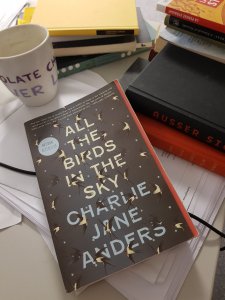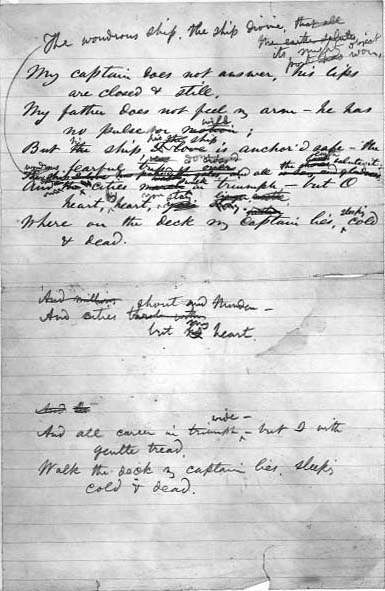Anders, Charlie Jane (2016), All the Birds in the Sky, Tor
ISBN 978-0-7653-7995-5
 So I love science fiction. And nothing bums me out more when a book or text or movie is marred by a lack of imagination or a conservatism that is both boring and extremely reactionary. I wrote an essay in The Fanzine on the topic. It’s particularly frustrating with books that are otherwise interesting and engaging. This brings us to Charlie Jane Anders’s novel All the Birds in the Sky which is a hybrid fantasy/science fiction novel that spans a long period of time, involves high school intrigue, adult disillusionment and a powerful war between science and magic. Oh, it also contains a very romantic love story. The novel contains so much. Written by someone who is clearly around silicon valley types a lot, the book discusses the atmosphere and thinking in tech start ups and how it connects to contemporary ways of viewing the world, it discusses magic and the romantic attitudes towards it. It discusses, movingly, the alienation of “weirdo” high school kids, and much of the novel focuses on a search for belonging – on how we make our communities, how we deal with ourselves, what role technology plays in this process and what role nature does. It’s an enjoyable read – but as with many fantasy novels, you’ll have to hold your nose about some aspects. In particular its oppressively anachronistic view of gender roles.
So I love science fiction. And nothing bums me out more when a book or text or movie is marred by a lack of imagination or a conservatism that is both boring and extremely reactionary. I wrote an essay in The Fanzine on the topic. It’s particularly frustrating with books that are otherwise interesting and engaging. This brings us to Charlie Jane Anders’s novel All the Birds in the Sky which is a hybrid fantasy/science fiction novel that spans a long period of time, involves high school intrigue, adult disillusionment and a powerful war between science and magic. Oh, it also contains a very romantic love story. The novel contains so much. Written by someone who is clearly around silicon valley types a lot, the book discusses the atmosphere and thinking in tech start ups and how it connects to contemporary ways of viewing the world, it discusses magic and the romantic attitudes towards it. It discusses, movingly, the alienation of “weirdo” high school kids, and much of the novel focuses on a search for belonging – on how we make our communities, how we deal with ourselves, what role technology plays in this process and what role nature does. It’s an enjoyable read – but as with many fantasy novels, you’ll have to hold your nose about some aspects. In particular its oppressively anachronistic view of gender roles.
Fantasy has the most annoyingly persistent conservative attitudes towards gender and gender roles – and while science fiction has recently (and traditionally, see Delany) offered diverging and interesting takes on these attitudes, one feels like in this case, the fantasy component of the novel has dragged its science fiction portions into the same regrettable conservative hole. In a novel that is so fundamentally based on the binary – science and magic, destruction and creation, nature and technology, it’s very sad that the author’s apparent reactionary views mar it all. By making the story fit a very simple heterosexual frame, and by connecting everything in line with the usual, very typical associations, there’s a lack of tension and intrigue to the structure of the book. The female protagonist, of course, likes nature and magic, and the male protagonist likes technology and maths. This is such a fundamentally anachronistic view of gender roles that you can find a critique of it in Wollstonecraft’s classic treatise on the subject. These associations have been recognized by progressive writers as anachronistic and reactionary for longer than the whole modern genre of fantasy and science fiction have existed. Which is some kind of achievement, I suppose. Interestingly, it doesn’t mar the readability of the book. In fact, in some sense, this conservative throwback view of gender connects with the old fashioned way the story is narrated: a sweeping, traditional kind of narrative, unafraid of big moments and well executed sentimentalism.
 Honestly, if this wasn’t partially science fiction, I wouldn’t have reacted negatively to its 1950s view of gender roles at all – if you are in the habit of reading fantasy novels, particularly epic fantasy, you know that this kind of thing is to be expected. Fantasy doesn’t usually, in my reading experience, enlarge the pool of possibilities in quite the same way as science fiction does. And All the Birds in the Sky downright teases us with its allusions to Donna Haraway, Deleuze and other theories of change, dissolution and new formations. There are so many possibilities, so much potential – the same thing that bothered me about the Luc Besson movie – and Charlie Jane Anders picks the most boring one, boring, that is, from a SciFi point of view. As fantasy, it mines a trope that works extremely well. Fantasy and romance are a great combination – with a lot of room to maneuver, too. Even in mainstream fantasy, one sometimes gets something not as GOP-approved straight as this one (Jen Williams, in her fantasy novels, has a remarkable hand at sketching gay attraction, for example), but let’s be fair – this is the norm. And it’s so well executed by Anders. Trust me, if you’re looking for romance, this is right up your alley. Not to mention that Anders is extremely skilled at writing erotic scenes. The whole package is wildly engaging. I have a weak spot for romance in fiction and on screen and boy did this novel deliver. Anders manages to pace her two storylines, one of the war between science and magic and the other one of the love story between her protagonists, extremely well, so that as one comes together slowly, haltingly, so does the other, and each story’s ebb and flow is mirrored on the other level, until the dramatic conclusion, which feels extraordinarily satisfying.
Honestly, if this wasn’t partially science fiction, I wouldn’t have reacted negatively to its 1950s view of gender roles at all – if you are in the habit of reading fantasy novels, particularly epic fantasy, you know that this kind of thing is to be expected. Fantasy doesn’t usually, in my reading experience, enlarge the pool of possibilities in quite the same way as science fiction does. And All the Birds in the Sky downright teases us with its allusions to Donna Haraway, Deleuze and other theories of change, dissolution and new formations. There are so many possibilities, so much potential – the same thing that bothered me about the Luc Besson movie – and Charlie Jane Anders picks the most boring one, boring, that is, from a SciFi point of view. As fantasy, it mines a trope that works extremely well. Fantasy and romance are a great combination – with a lot of room to maneuver, too. Even in mainstream fantasy, one sometimes gets something not as GOP-approved straight as this one (Jen Williams, in her fantasy novels, has a remarkable hand at sketching gay attraction, for example), but let’s be fair – this is the norm. And it’s so well executed by Anders. Trust me, if you’re looking for romance, this is right up your alley. Not to mention that Anders is extremely skilled at writing erotic scenes. The whole package is wildly engaging. I have a weak spot for romance in fiction and on screen and boy did this novel deliver. Anders manages to pace her two storylines, one of the war between science and magic and the other one of the love story between her protagonists, extremely well, so that as one comes together slowly, haltingly, so does the other, and each story’s ebb and flow is mirrored on the other level, until the dramatic conclusion, which feels extraordinarily satisfying.
One of the most interesting aspects of the whole set-up is that the idea of shifts and shape-changing, despite me mentioning Haraway just now, isn’t just a riff on the idea of the cyborg, or anyway not in the way you’d expect. Yes, the technological part of the story is in many ways a story about augmentation, about changing the limited abilities of human beings to achieve means seemingly out of reach. And to Anders’s great credit, the book isn’t full of artificial limbs or other boring feats of imagination. The very first invention we are made aware of is a clock that allows its wearer to jump just a handful of seconds into the future. It’s not a time machine, not anyway as you’d imagine it. Its effect is small enough that it works, indeed, like an augmentation, like a stronger limb or a better eye, but Anders picked an unexpected human ability to augment – to interact with time. The small amount of seconds truly makes it akin to moving a bit faster, or seeing a bit better. As time goes on, the gains, the leaps with technology get bigger, and less pleasurably surprising. I don’t mean this in a bad way, but Anders just settles more comfortably into various genre tropes. Artificial intelligences, wormholes, she uses many things that we know from science fiction, in the exact way we know them to work. She distinguishes herself in these sections specifically through her enormous skill. The whole book reads as if it went through a hundred drafts, because all the details work, the allusions, the structure.
This includes a character that tries to stop a catastrophe by finding the people who will cause the catastrophe and killing them as children or at least stop them from doing their evil deed. That person’s narrative is a roving narrative, it doesn’t fit the solemn binary nature of the whole book, and, consequentially, she writes this character differently. He wears his influences much less lightly than the two protagonists, he is much more obviously a compositum, and Anders’s very tone in the prose reflects this.
 But to get back to why this book doesn’t use Haraway in the way you’d expect – it’s not just the technological parts that are augmenting. The natural – regrettably gendered female, as technology was gendered male – part of the equation is also about augmentation, and about becoming more, doing more, understanding more. The initial augmentation, the mirror of the tiny time jump I mentioned, is the ability to talk to animals, but not fluently, at will and at all times, but a stubborn, halting, difficult ability that could, in some ways, be seen as an augmentation of human empathy, human abilities to understand animals through gestures, tone etc. Making this ability this inaccessible, and hard to use, was an extraordinary authorial decision, that doesn’t fit the usual smooth discoveries of magic. Often, while actually using magic skill is shown to be hard, fantasy novels treat the discovery of mere magical ability like the discovery of someone, thrown into water, that they can, indeed, breathe under water. This decision, and several others, show us a writer who has done some careful thinking about genre and how it works and how it is usually presented. It is such a shame, and such a bummer that Charlie Jane Anders decided to stop there, and thus meshed this intelligent careful use of tropes with this medieval view of gender roles, not to mention class or race. Maybe she kept to 1950s attitudes because of the enormous colorful way the whole book works. I mean it’s so much fun, even in the dramatic parts.
But to get back to why this book doesn’t use Haraway in the way you’d expect – it’s not just the technological parts that are augmenting. The natural – regrettably gendered female, as technology was gendered male – part of the equation is also about augmentation, and about becoming more, doing more, understanding more. The initial augmentation, the mirror of the tiny time jump I mentioned, is the ability to talk to animals, but not fluently, at will and at all times, but a stubborn, halting, difficult ability that could, in some ways, be seen as an augmentation of human empathy, human abilities to understand animals through gestures, tone etc. Making this ability this inaccessible, and hard to use, was an extraordinary authorial decision, that doesn’t fit the usual smooth discoveries of magic. Often, while actually using magic skill is shown to be hard, fantasy novels treat the discovery of mere magical ability like the discovery of someone, thrown into water, that they can, indeed, breathe under water. This decision, and several others, show us a writer who has done some careful thinking about genre and how it works and how it is usually presented. It is such a shame, and such a bummer that Charlie Jane Anders decided to stop there, and thus meshed this intelligent careful use of tropes with this medieval view of gender roles, not to mention class or race. Maybe she kept to 1950s attitudes because of the enormous colorful way the whole book works. I mean it’s so much fun, even in the dramatic parts.
One reason I may have been disappointed is that, at the same time as All the Birds in the Sky, I read and reviewed Gwyneth Jones’s most recent book – and Jones takes on a very similar topic, but she takes only the sci-fi aspects: as in All the Birds in the Sky, there’s a think tank that tries to find a way to save humanity, that tries to open something akin to a worm hole, and that spends approximately as little time thinking about the consequences in a race to push through a scientific barrier. Like Anders, Jones’s book touches on the ecological aspect (though Anders’s book is specifically about ecology in a way that Jones’s book isn’t). But Proof of Concept is a dark novel, and not ultimately as hopeful as Anders’s fable. Jones is daring in terms of what humanity means for our bodies, in a way that Anders is not, but one feels that to use all these ideas in the sharp way that Jones does would not allow for the engaging, joyful, almost, ride that All the Birds in the Sky clearly is. So I understand why Anders made the decisions she did. Doesn’t mean I have to like it. The book itself, outside of its medieval attitudes, I loved. If you don’t like the book, you don’t like fun. I don’t always need innovation. Sometimes, nigh-perfect execution and the sparkle of narrative is a lovely thing to have, also. Read the dang thing already.
*
As always, if you feel like supporting this blog, there is a “Donate” button on the left and this link RIGHT HERE.





